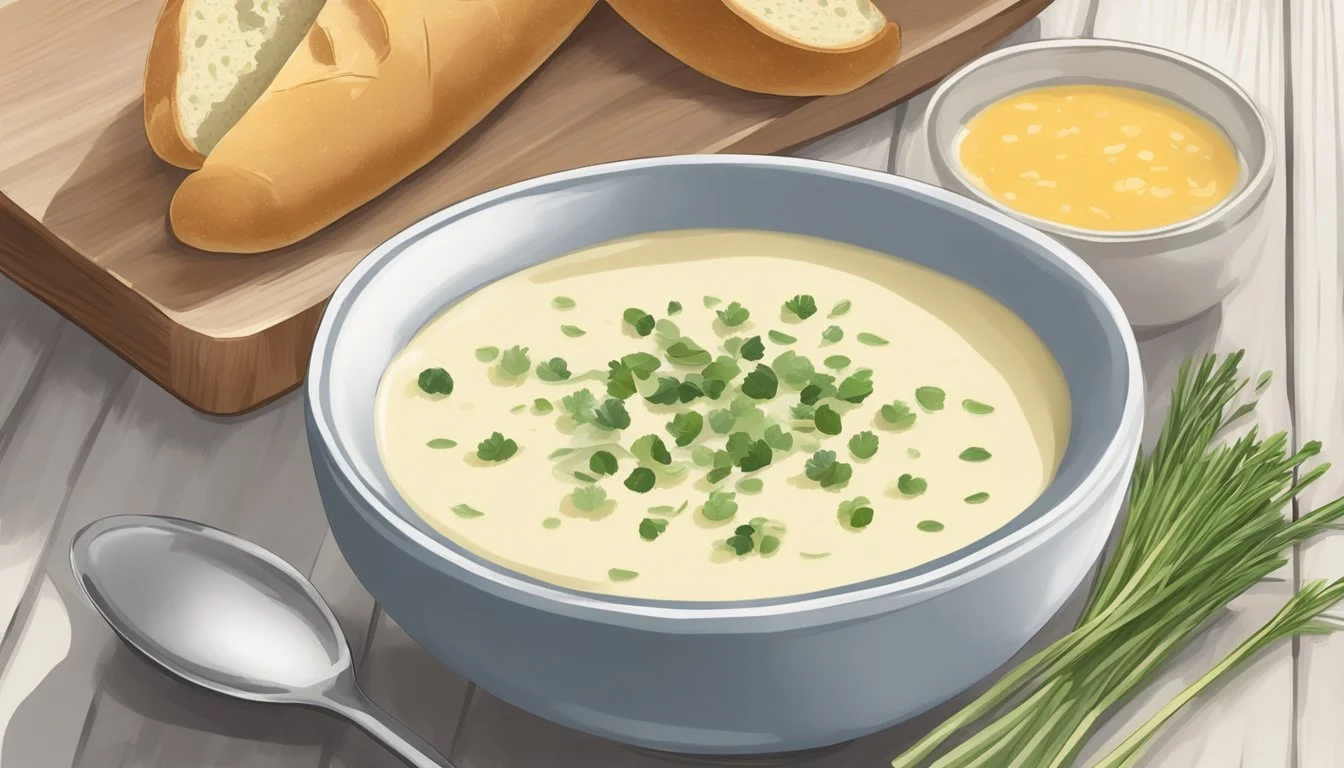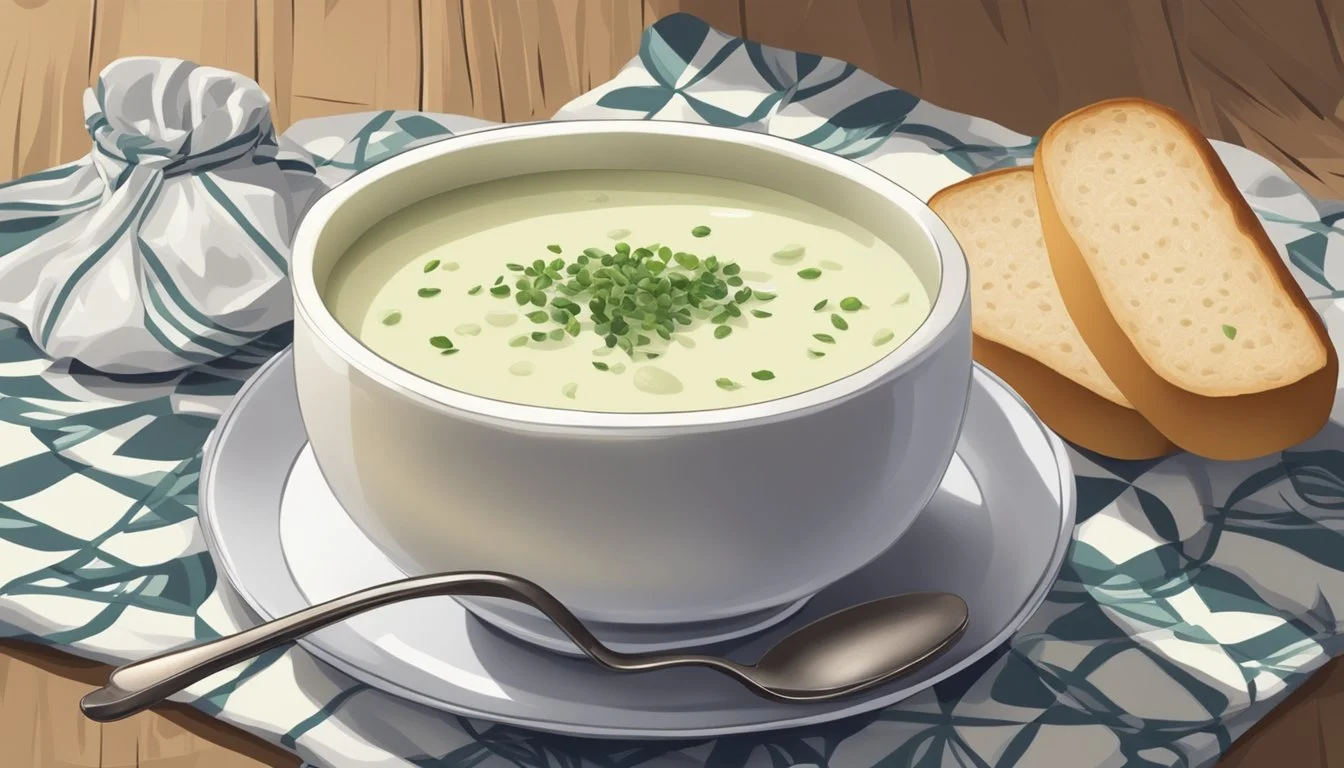How do you eat a Vichyssoise?
Serving Suggestions for This Classic Chilled Soup
Vichyssoise is a smooth, creamy soup traditionally made with leeks, potatoes, (What wine goes well with potatoes?) chicken stock, and heavy cream. Often served chilled, it is a classic French dish that has found its way into kitchens worldwide due to its elegant simplicity and comforting taste. The soup is versatile in its presentation and can be enjoyed both as a refreshing starter during the warm months or a comforting dish when served hot.
Eating vichyssoise correctly enhances its delicate flavors and creamy texture. To experience its full richness, it should be consumed with a soup spoon, ensuring that each spoonful contains an even blend of the pureed vegetables and the silky broth. Typically garnished with fresh herbs such as chives (how long do chives last?), the soup offers a subtle balance of earthy and savory notes. It's essential to stir the vichyssoise before serving, as the cream may separate when chilled.
Vichyssoise presents a unique culinary experience due to its temperature flexibility. Chilled vichyssoise provides a cooling effect, making it an ideal choice for summer dining, while the heated version suits colder weather by providing warmth and richness. Its ability to pair with various side dishes, ranging from light salads to more protein-rich options, adds to its appeal as a versatile and sophisticated choice for any occasion.
History and Origin of Vichyssoise
Vichyssoise is a classic soup known for its chilled serving temperature and creamy texture, created in the early 20th century by a French chef. This section explores its invention and subsequent cultural impact.
Creation by Louis Diat
Louis Diat, a chef hailing from Montmarault, France, is credited with the creation of vichyssoise. In the early 1900s, Diat was working at the Ritz-Carlton in New York City when he developed the recipe. The soup is a puréed mixture of leeks, potatoes, onions, and cream. Diat's inspiration came from his childhood memories of adding cold milk to a hot potato and leek soup to cool it down.
Vichyssoise in Popular Culture
The vichyssoise gained notoriety beyond its initial creation by Louis Diat, becoming a staple in French cuisine and American cookbooks. Julia Child featured the soup in her renowned cookbook, Mastering the Art of French Cooking. The dish became emblematic of French culinary art, often associated with elegance and fine dining. Its place in popular culture solidified as it was frequently referenced in films, literature, and television as a symbol of sophisticated cuisine.
Fundamental Ingredients
The classic Vichyssoise combines select ingredients that are essential for its velvety texture and subtle flavors. Each component is chosen with care to create a harmonious blend in this chilled soup.
Potatoes in Vichyssoise
Vichyssoise employs starchy potatoes as a base, with Yukon Gold potatoes being a preferred variety due to their buttery texture and ability to create a smooth puree. One should ensure the potatoes are well-cooked to achieve the right consistency.
Leeks: A Crucial Component
Leeks impart a mild, yet distinctive onion-like flavor crucial to an authentic Vichyssoise. They should be thoroughly washed to remove any grit and gently sautéed, traditionally in unsalted butter, to avoid overpowering the delicate taste of the soup.
Dairy Elements: Cream and Milk
Dairy provides the creamy texture synonymous with Vichyssoise. A combination of heavy cream and milk is often used, with cream added during the cooking process and a touch of cream or whole milk blended in before serving. For dietary preferences, vegetarian, vegan, or kosher alternatives can be used, such as plant-based cream or milk.
Preparation Techniques
In crafting an exquisite vichyssoise, chefs focus on achieving a silken texture, balancing flavors for taste enhancement, and mastering the chilling and serving methods to ensure the dish is enjoyed as intended.
Proper Blending for Smoothness
A crucial step in preparing vichyssoise is creating a velvety purée, which relies on the use of a proper blending device. An immersion blender or a food processor aids in achieving the needed smoothness, by thoroughly blending the cooked leek and potato mixture. If neither is available, a standard blender or stick blender can serve as a substitute. To refine the texture further, it may be passed through a sieve to remove any remaining lumps.
Seasoning and Taste Enhancement
The seasoning process is integral to the flavor profile of vichyssoise. Chefs recommend precise seasoning, paying special attention to the addition of white pepper and salt for a clean taste that complements the soup’s creamy base. If desired, a dollop of sour cream can be added either during blending for richness or as a garnish upon serving.
Chilling and Serving Methods
Vichyssoise is traditionally served cold, making the refrigerator an essential tool. After the soup has been pureed and sieved, it should be transferred to a suitable container and refrigerated for at least four hours, allowing the flavors to meld. To serve, ladle the chilled soup into bowls, garnish as desired with chives, an extra drizzle of cream, or a spoonful of sour cream.
Variations and Additional Flavors
Vichyssoise, a classic French cold soup, can be customized with a variety of vegetables and proteins, and be spiced up with unique, international twists. Experimentation does not compromise the integrity of the dish but rather complements the creamy texture and subtle taste.
Vegetable and Protein Additions
The traditional vichyssoise recipe can be enriched with additional vegetables to enhance both flavor and nutritional value. Incorporating peas can add a gentle sweetness and a vibrant green color, making the soup even more appealing. For a more substantial dish, chefs might choose to include proteins such as shredded chicken or lump crab (What wine goes well with crab?) meat, which can be gently stirred in once the soup is cool to maintain texture.
International and Contemporary Twists
An international approach to vichyssoise borrows elements from other cuisines, such as the Spanish gazpacho which inspires the addition of robust flavors like roasted red peppers and tomatoes—though these should be used judiciously to maintain the soup's characteristic subtlety. Contemporary twists might also include infusing the soup with culinary trends, such as a touch of truffle oil for earthiness or garnishing with microgreens for a fresh, modern presentation.
Nutritional Information
The nutritional content of vichyssoise, a creamy potato-leek soup, can be important for individuals monitoring their dietary intake. This section provides a detailed look at its calorie and fat content and discusses dietary considerations related to vegetarian and vegan preferences.
Calorie and Fat Content
Vichyssoise contains approximately 146 calories per one-cup serving. The soup's calorie content is a composite of macronutrients, primarily carbohydrates, with a moderate amount of fat and protein. In a standard serving, the calorie makeup is:
Fat: 29%
Carbohydrates: 62%
Protein: 9%
When examining fat content, vichyssoise generally has a lower fat percentage compared to many cream-based soups (What wine goes well with soups?), due to its leek and potato foundation. However, variations in recipes can increase fat content, especially when more cream or butter is added.
Dietary Considerations
Vegetarian: Vichyssoise is typically suitable for vegetarians, as it does not inherently contain meat products. Ingredients like leeks, potatoes, and cream adhere to a lacto-vegetarian diet.
Vegan: Traditional vichyssoise is not vegan due to the use of chicken broth and cream. However, it can be modified by substituting with vegetable broth and almond or coconut cream to cater to vegan dietary needs.
The soup's nutritional facts should be considered in the context of an individual's overall diet. The content may vary based on modifications in the recipe, portion size, and specific dietary requirements.
Storage and Preservation
Proper storage ensures that vichyssoise maintains its quality and safety. Vichyssoise should be kept chilled, as it is traditionally served cold, and should be stored in a manner that preserves its fresh flavors.
Refrigeration Guidelines
One should store vichyssoise in the refrigerator immediately after it has cooled to room temperature. To retain freshness, an airtight container is paramount. Vichyssoise is best enjoyed within 48 hours, as this timeframe helps to maintain the optimal taste and texture of the soup. When storing, dividing into individual servings can be convenient for future consumption.
Freezing for Long-Term Storage
Although vichyssoise is best enjoyed fresh, one can freeze it for extended storage. Use an airtight container or a freezer-safe bag to prevent freezer burn and flavor loss. When freezing, leave about an inch of space at the top of the container as the soup will expand as it freezes. Thawed vichyssoise should be eaten within 24 hours and should never be refrozen. It's crucial to note that freezing may alter the creamy texture somewhat due to the heavy cream content.
Serving and Pairing Suggestions
When enjoying vichyssoise, one must consider both the garnishes that can enhance its flavors and the accompanying dishes and drinks that create a harmonious dining experience. This cold leek and potato soup, traditionally creamy and subtle in flavor, can be elevated with the right additions.
Appropriate Garnishes
An array of garnishes can be utilized to add both visual appeal and layers of taste to a vichyssoise. Essential garnishes include:
Fresh chives: Finely chopped for a mild onion-like flavor
Parsley: Fresh and lightly chopped to sprinkle on top for a herbaceous touch
Thyme: A pinch of fresh thyme leaves to infuse an earthy aroma
Crab meat: A small amount of delicate crab meat for those seeking a luxurious twist
Accompanying Dishes and Drinks
The pairing possibilities with vichyssoise are vast. To complement the soup as a starter, one could serve:
Roasted Chicken: (What wine goes well with roasted chicken?) Succulent and herbed, it provides a satisfying protein contrast to the smooth soup.
Focaccia: A slice of this Italian bread works as a flavorful scoop.
Caesar Salad: A classic starter that shares a rich, creamy profile with the soup.
For drinks, a chilled white wine, such as a Sauvignon Blanc, pairs excellently, cutting through the creaminess and refreshing the palate.
Cultural and Culinary Significance
Vichyssoise, a chilled soup primarily composed of leeks and potatoes, occupies a unique place in French cooking and international cuisine. The dish is known for its refreshing qualities and is often consumed during warmer seasons.
One might consider vichyssoise to represent the ingenuity of French chefs, particularly Louis Diat, who is credited with its creation in the early 20th century. It reflects the French culinary philosophy of elevating simple ingredients—in this case, leeks and potatoes—to a dish of significant stature.
Here are some key points of interest:
Origins: Credited to French chef Louis Diat, who created the chilled leek and potato soup at the Ritz-Carlton in New York.
Texture and Flavor: Served cold, vichyssoise is known for its smooth, creamy texture that comes from the use of heavy cream, and it bears the subtle, sweet onion-like flavor of leeks enhanced by a garnish of chopped chives.
Cultural Impact: Vichyssoise challenges the norm of hot soups and has found a place as a summer staple in many Western countries. It has blurred the lines traditionally separating cold soups from warm ones.
Historical Anecdotes: The story of King Louis XV and his fear of being poisoned, which resulted in his soup being served cold after several taste tests, adds a layer of historical intrigue though it is likely apocryphal in relation to the actual origin of vichyssoise.
This soup's status as a classic of French cooking and its international adoption as a popular dish underscores the global appeal of a simple yet sophisticated culinary creation. Vichyssoise stands as a testament to the enduring legacy of French gastronomy and the universality of a chilled soup's appeal.










